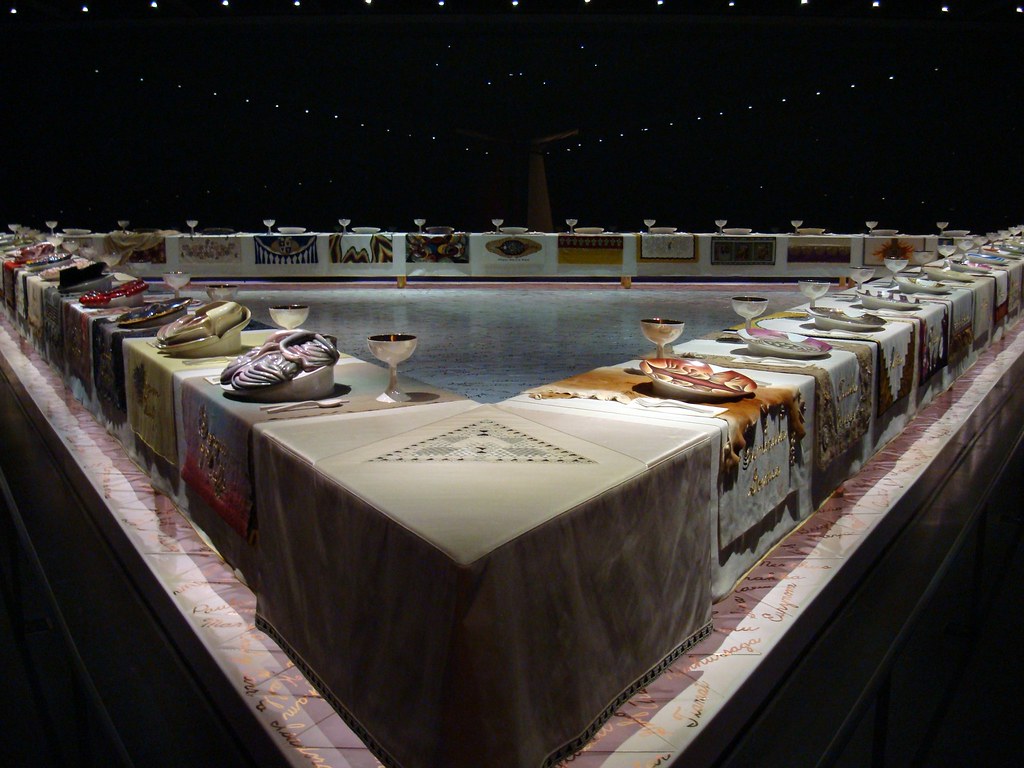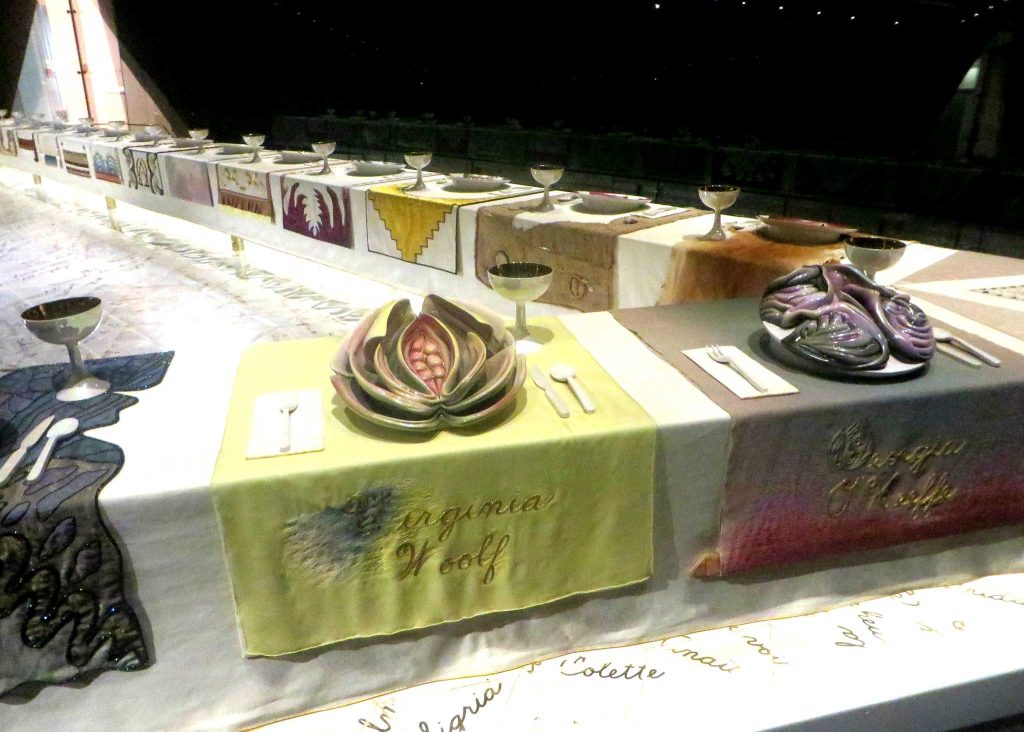Chapter 5.3: Art Criticism: Additional Perpectives
Art Criticism is essentially the discussion of the meaning that can be discovered in artwork. The professional art critic, through their writing, may endorse or reject particular kinds of art for its style, artistic ability or message. In fact, a study of the different ways to look at art also tells us about changing times and philosophies because the role of aesthetics, economics and other cultural issues help shape our point of reference. Of course, none of them are completely true because each person approaches meaning from different perspectives. Think of the artwork as a silent participant while all around them the voices and opinions are changing over time. Here are six different perspectives art critics use as a guide to interpret meaning:
Structural Criticism
Structuralism is based on the notion that our concept of reality is expressed through language and related systems of communication. Try to visualize culture as a structure whose foundation is language, speech and other forms of communication. When this approach is applied to the visual arts, the world of art becomes a collective of human artworks, where a single work needs to be judged within the framework supported by the whole known structure of art. This structure is still based in language and knowledge and how we communicate ideas.
Deconstructive Criticism
Deconstructive criticism goes one step further, and insists that any work of art can have many meanings attached to it, none of which are limited by a particular language or experience outside the work itself. In other words, the critic must reveal (deconstruct) the structured world in order to knock out any base of stereotypes, preconceptions or myths that get in the way of true meaning.
Formalist Criticism
Formalist criticism is what we are doing when analyzing the elements and principles of art. Formalism doesn’t really care about what goes on outside the actual space of the work, but finds meaning in its use of materials. One of the champions of the formalist approach was Clement Greenberg. His writing stresses “medium specificity”: the notion there is inherent meaning in the way materials are used to create the artwork. The Formalism approach gives us a better discussion of abstract and nonrepresentational art because abstract and nonrepresentational are themselves focused on materials. In other words, we are only concerned with medium which takes the place of subject matter. Greenberg was a strong defender of the Abstract Expressionist style of painting that developed in the United States after World War II. He referred to it as “pure painting” because of its insistence and focus on the act of painting itself which resulted in a more nonrepresentational type of work.
Ideological Criticism
Ideological criticism is most concerned with the relationship between art and political power. It reasons that art is embedded in a social, economic and political structure that determines its final meaning. Ideological criticism translates art and artifacts as symbols that reflect political ideals and reinforce one version of reality over another. A literal example of this perspective would be our views of the Lincoln Memorial in Washington DC. It can be seen as a testament to a political system that oppressed people because of race, yet also reflect the political will to end slavery at the end of the Civil War.
Psychoanalytic Criticism
Psychoanalytic criticism is the way we should look at work if we feel it is only about personal expression. The artist viewpoint is more important than any other reason the art happens. In the purest form of this criticism the work of untrained and mentally ill artists are just as important as any other art. When discussing Vincent van Gogh, you will often hear people make mention of his mental state more than his actual artwork, experience, or career. This is a good example of psychoanalytic criticism. One of the problems in this type of criticism could be that the critic is discussing issues the artist themselves may be totally unaware of or would deny exist.
Feminist Criticism
Feminist criticism began in the 1970’s as a response to the neglect of women artists over time and in historical writings. This form of criticism is specific to viewing art as an example of gender bias in historical western European culture. Feminist criticism created whole movements in the art world (specifically performance based art), and has changed over the last few years to include all underrepresented groups. Examples of feminist art include Judy Chicago’s large-scale installation The Dinner Party and the work of Nancy Spero. In reality, all of these critical perspectives hold some truth. Art is a multifaceted medium that contains influences and characteristics from the culture it was created in and in some cases there are works that transcend cultural environments. These perspectives can help us to discover some of the mysteries inherent in works of art, and bring us closer to understanding how art expresses the feelings, ideas and experiences we all share. In the end it is important to be aware of all the issues involved, consider each critical position depending upon the work being viewed, and the context you’re seeing it in, and then make up our own mind!


Now that we have completed our study into the formal language of art let’s watch some of the ways in which artists view their work. This film offers a series of short and dynamic interviews with amazing modern artists, giving us an insight into their mediums and creative process.
Art and Design: Insights into the Visual Arts (59:07)
Glossary
-
- Art Criticism:
The discussion of the meaning that can be discovered in artwork. - Structural Criticism:
Criticism based on the notion that our concept of reality is expressed through language and related systems of communication. - Deconstructive Criticism:
Revealing (deconstructing) the structured world in order to knock out any base of stereotypes, preconceptions or myths that get in the way of true meaning. - Formalist Criticism:
Analyzing the elements and principles of art. - Ideological Criticism:
Analyzing the relationship between art and political power. - Psychoanalytic Criticism:
Looking at work as if it is only about personal expression. - Feminist Criticism:
Form of criticism specific to viewing art as an example of gender bias in historical western European culture.
- Art Criticism:
Media Attributions
- Figure 1. Judy Chicago, The Dinner Party. Mixed-Media Installation, 1974-1979. The ceremonial table has 39 placesettings, each representing an important historical female figure. Each table side is 48′ long, and each plate is 14″ in diameter. Brooklyn Museum, New York (Source: Neil R. via Flickr) is licensed under a CC BY-NC (Attribution NonCommercial) license
- Figure 2. Close-up of the place settings for Virginia Woolf and Georgia O’Keefe as part of the mixed media installation, The Dinner Party by Judy Chicago.Brooklyn Museum. (Source: Eden, Janine and Jim via Flickr) is licensed under a CC BY (Attribution) license
Candela Citations
- Boundless Art History: Visual Elements. Authored by: Lumen Learning. Retrieved from: https://www.collegesidekick.com/study-guides/boundless-arthistory/visual-elements. License: CC BY-SA: Attribution-ShareAlike

